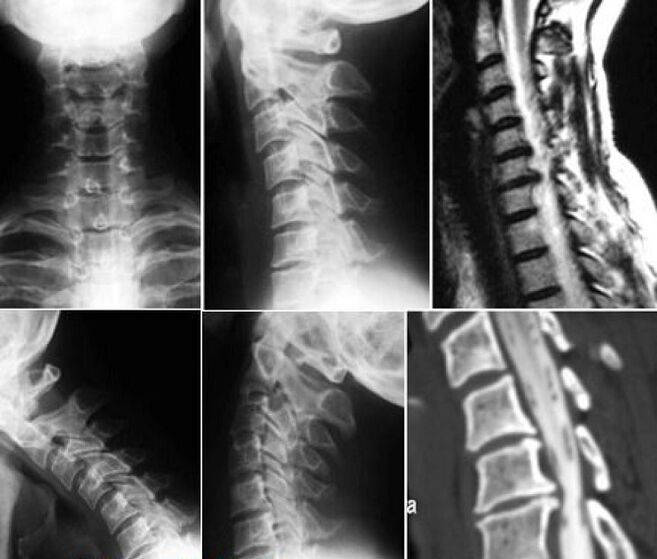Cervical osteochondrosis is typical of modern people due to an unhealthy lifestyle. Problems with nutritional deficiencies in the brain tissues caused by them can lead to many complications, including deadly ones.
It is important to identify the development of pathology in time. In the early stages, the treatment of cervical osteochondrosis is quite successful.
Signs and symptoms of the disease
The cervical spine includes seven vertebrae. Each of them has its own function, but they all serve to support the head and neck movement.
The vertebrae are separated by special discs, the connective tissue of which is destroyed in osteochondrosis. This leads to a change in the location of the vertebrae, loss of flexibility of the spine, pinching of blood vessels and nerves. Due to the latter pathology, the blood supply to the brain is disrupted.
The symptoms of the disease are associated with pressure on the nerve endings and blood vessels. The main features are:
- Pain in the back of the head and other parts of the head, dizziness.
- Cracking and "goose bumps" on the neck when moving the head.
- Painful sensations when raising arms up.
- Numbness of the arms and neck, as well as of the back muscles, their constant tension.
- Coordination problems.
- Bad dreams, insomnia.
- Nausea, tinnitus, vomiting.
- Mood swings.

With prolonged exposure to the nerves and blood vessels, it is possible to reduce memory, concentration, and speech problems.
There are three stages of the disease, each with characteristic symptoms:
- Initial. . . She is accompanied by the first "alarm bells" of the disease - dizziness, tinnitus, constant fatigue, pain and numbness in the cervical spine, irritability, sleep problems.
- Subcompensatory. . . The disease suppresses the functioning of the central nervous system. Intellect decreases, speech problems arise, the patient suffers from mood swings. Possible impaired coordination of movements, nausea, vomiting.
- Decompensatory. . . Pathological changes become irreversible and deadly. Most of the symptoms are persistent.
The sooner you find signs of an illness and the sooner you seek medical help, the easier and more effective the treatment will be.
Causes of the disease
Cervical vertebrae are smaller and more fragile in size and structure than similar bones in other vertebral sections. In addition, they are the most mobile. All this leads to increased stress on the cervical spine and pathological transformation of the intervertebral discs. Under the influence of changes caused by osteochondrosis, small vessels and nerve roots are squeezed.
Lack of movement during sedentary work always leads to metabolic failure and an increase in the level of salts in the lymph and blood. They accumulate in the cervical region. An unhealthy diet and excess weight will spur metabolic problems, and a lack of valuable vitamins and minerals will aggravate degenerative phenomena in connective tissues.
The main reasons for the development of pathological processes include:
- Hypodynamia.
- Staying in the same position for a long period (at the computer, driving).
- Salt deposits.
- Improper diet, leading to metabolic disorders.
- Lack of valuable vitamins and minerals.
- Excessive body weight.
- Injuries and chronic ailments of the musculoskeletal system.
- Regular hypothermia.
- Hormonal disruptions.
Most risk factors can be eliminated by changing lifestyle and balancing metabolic processes in the body.
What are the risks of problems with cerebral circulation?
A third of the nutrients enter the brain through the vertebral arteries. If they begin to narrow, and small vessels are pinched due to osteochondrosis, then the brain tissue suffers from a deficiency of oxygen, as well as valuable trace elements and vitamins.
Why is starvation of the brain dangerous?
- Dysfunctions of the heart and blood vessels.
- Disorders of the musculoskeletal system (especially the shoulder).
- Increased intracranial pressure.
- Microstrokes, and subsequently serious cerebral hemorrhages.
Neglected conditions can provoke encephalopathy - a dangerous ailment that causes dystrophy of brain tissue.
All these pathological conditions can develop if you do not pay attention to the first signs of osteochondrosis and vascular dysfunction. If the disease is diagnosed in the early stages, dangerous consequences can be avoided.
Visual and hardware diagnostics
To find out exactly the causes and stage of the disease, a comprehensive examination is carried out:
- Visual examination with palpation of the cervical spine.
- Checking posture and coordination of movements.
- Neck flexibility assessment.
An experienced doctor can make a preliminary diagnosis by looking at how you walk and move your head.
Hardware studies of problem organs are also mandatory. These include:
- Radiography.
- Doppler ultrasound.
- Rheoencephalography and angiography of cerebral vessels.
- Computed tomography or MRI.
- Electrocardiography.

The results will help to identify damaged discs, to clarify the degree of damage to blood vessels, tissues of the spine and brain. When a diagnosis is made, treatment is started immediately.
Medication and non-medication treatment
If the course of the disease is accompanied by severe pain and swelling, first of all, they should be removed. To do this, use analgesics or massage of the cervical region with anesthetic drugs.
Sometimes doctors recommend using an applicator that not only relieves pain, but also relieves spasms. Pepper patches can help reduce pain in some cases. Puffiness is eliminated with the help of diuretics.

Further therapy of the disease can be divided into two areas: the treatment of osteochondrosis with the restoration of the spine and the improvement of blood circulation in the brain tissues and neuronal metabolism.
It will take time to get rid of osteochondrosis. To restore health to the spine, drug and non-drug therapy is used.
The latter includes:
- Remedial gymnastics.
- The help of a masseur.
- Proper nutrition.
- Acupuncture.
- Physiotherapy.
The best physiotherapy techniques include electrophoresis and magnetotherapy. The first type of procedures helps relieve muscle spasms, the second - dilates blood vessels and improves intercellular metabolism.
With osteochondrosis, smoked meats, fried foods, fast food, carbonated drinks are not recommended. Chicken and rabbit meat, boiled fish, vegetables and fruits, herbs are considered healthy products.
In addition to anti-inflammatory and analgesic drugs, chondroprotectors are used to restore the spine - agents that renew the cartilage tissue in the intervertebral discs. If abnormal muscle tension is observed, muscle relaxants may be used.
To improve blood flow to the brain and neuronal metabolism, the doctor also prescribes pharmaceuticals. These include:
- Vasodilators and blood thinners.
- Nootropics that improve metabolism in brain tissues. They restore concentration and memory.
- Histaminergic drugs. Stimulates specific receptors in the inner ear to help relieve vestibular dysfunctions and improve motor coordination.
- AntioxidantsIncrease resistance to destruction of brain cell membranes, stop destructive oxidative reactions.

Additionally, doctors recommend vitamin and mineral complexes to restore the body weakened by the disease.
Only a specialist can prescribe pharmaceuticals and medical procedures. Self-medication is unacceptable and deadly.
Prevention: how to prevent illness
The causes of violations lie precisely in unhealthy habits. To avoid unpleasant consequences, you must:
- Normalize body weight.
- Forget about bad habits.
- Avoid hard work and strength sports after injury or bruising.
- Do not overcool.
- Do not succumb to stress.
- Balance your diet.
- Distribute loads correctly.
- Visit the pool and massage room.
- Go in for sports without harm to health.
In one day, rarely anyone can change life in the right direction; the transition should be carried out gradually.
Medical assistance is needed at the first signs of cervical osteochondrosis. Timely measures taken will avoid serious consequences.
























